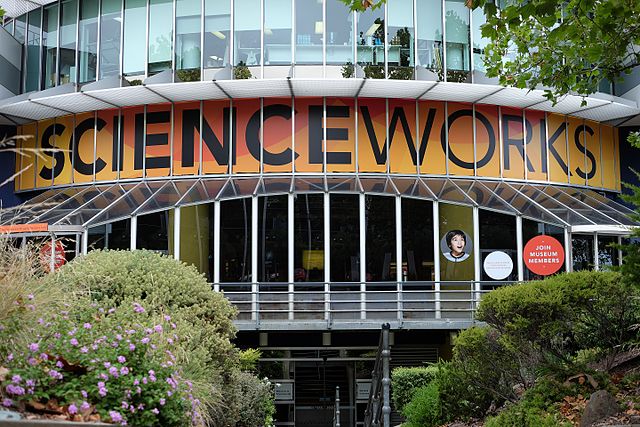Loading AI tools
Museums Victoria
Museum operator in Victoria, Australia From Wikipedia, the free encyclopedia
Museums Victoria is an organisation that includes a number of museums and related bodies in Melbourne. These include Melbourne Museum, Immigration Museum, Scienceworks, IMAX Melbourne, a research institute, the UNESCO World Heritage-listed Royal Exhibition Building and a storage facility in Melbourne's City of Merri-bek.
 Melbourne Museum, Museums Victoria's main campus | |
 Interactive fullscreen map | |
Former name | Museum of Victoria, Museum Victoria |
|---|---|
| Established | 1854 |
| Location | Melbourne, Victoria, Australia |
| Coordinates | 37°48′12″S 144°58′18″E |
| Type | Natural history, cultural history, and science and technology |
| Founder | Frederick McCoy |
| CEO | Lynley Crosswell |
| Website | museumsvictoria.com.au |
As the custodian of more than 15 million collection items, Museums Victoria traces the natural, social and cultural records of the Australasian region. Cultivated over nearly two centuries, this invaluable collection enables nationally and globally significant research. Their natural history collections are especially vital to scientists shaping conservation strategies through research, tracing the impacts of the world’s changing environment on biodiversity. Launched in 2022, Museums Victoria Research Institute addresses some of the biggest and most complex challenges of the era through a lens of change, drawing on multiple knowledge systems and perspectives to enrich understanding.
Museums Victoria also contains a library collection that holds some of Australia’s rarest and finest examples of 18th and 19th century scientific monographs and serials.
In partnership with First Peoples, Museums Victoria places First Peoples’ living cultures, histories and knowledge at the core of its practice. The organisation continues to embed the values of First Peoples communities into the organisational fabric by working in partnership with Elders and community members to return cultural material and knowledge to Country. Together, they create exhibitions and experiences that connect visitors with knowledge and stories spanning thousands of years, helping today’s generations understand the importance and vibrancy of Aboriginal and Torres Strait Islander cultures.
Welcoming more than 2 million annual visitors, Museums Victoria comprises some of the most popular tourist attractions in the state. Beyond the museum walls, its dedicated outreach programs and digital platforms reach more than 10 million people each month. And as a leading contributor to the Victorian education sector, it provides digital and onsite education programs with a focus on early childhood learning and improving STEM literacy for all.



The museum traces its history back to the establishment of the "Museum of Natural and Economic Geology" by the Government of Victoria, William Blandowski and others in 1854.
The Library, Museums and National Gallery Act 1869 incorporated the Museums with the Public Library and the National Gallery of Victoria; but this administrative connection was severed in 1944 when the Public Library, National Gallery and Museums Act came into force, and they became four separate institutions once again.[1]
Museums Victoria was founded in its current form under the Australian Museums Act (1983).[2] Currently, Museums Victoria's State Collections holds over 17 million items, including objects relating to Indigenous Australian and Pacific Islander cultures, geology, historical studies, palaeontology, technology & society, and zoology[3][4] Museums Victoria also contains a library collection that holds some of Australia’s rarest and finest examples of 18th and 19th century scientific monographs and serials.[5]
Significant events in the Museum's history include:
The present chief executive officer of Museums Victoria is Lynley Crosswell (formerly Marshall), who was previously the head of the Australian Broadcasting Corporation’s international arm. Crosswell is the first woman to lead the organisation in its history.[8]
Former directors include:
Museums Victoria has been building and researching its collections since 1854, recording Australia's environmental and cultural history.
Currently, Museums Victoria holds a collection of an estimated 15 million items, held in high-quality storage facilities at Melbourne Museum, Scienceworks and a specialised storage facility. Collection managers, conservators and curators research, document and preserve the collections for present and future generations.
Collections are held in these areas: geology, historical studies, indigenous cultures, library, paelontology, technology and society and zoology.
Based at Melbourne Museum and Launched in 2022, the Museums Victoria Research Institute has re-imagined how Museums Victoria does research and amplifies its strengths as Australasia’s leading museum organisation to address some of the biggest and most complex challenges of our era.
The Museums Victoria Library collection was first established in the 1850s as a working collection for the Museum's curators, and has developed into one of the best collections of natural history books and journals in Australia. The library was located at Melbourne University until 1906 when it moved, with the museum, to be co-located with the Public Library.[9]
Today, the library collection is located at Melbourne Museum and contains 40,000 titles, which includes around 1,000 titles that are considered to be rare due to one or a combination of factors, including: value; scarcity; aesthetic qualities; historic, scientific or institutional significance; fragility; or age.[10] Collection strengths include natural history in the fields of zoology, geology and palaeontology, scientific expedition reports, society and institutional journal titles, Indigenous cultures of Australia and the Pacific, Australian history, technology, colonial and other exhibition catalogues, museum studies, and Museums Victoria publications.[11]
Many items from the Museums Victoria Library have been digitised for the Biodiversity Heritage Library[12] as Museums Victoria is the home to the Australian node of this project. The digitisation operation is hosted by Museums Victoria and is nationally funded by the Atlas of Living Australia.[13]
Seamless Wikipedia browsing. On steroids.
Every time you click a link to Wikipedia, Wiktionary or Wikiquote in your browser's search results, it will show the modern Wikiwand interface.
Wikiwand extension is a five stars, simple, with minimum permission required to keep your browsing private, safe and transparent.